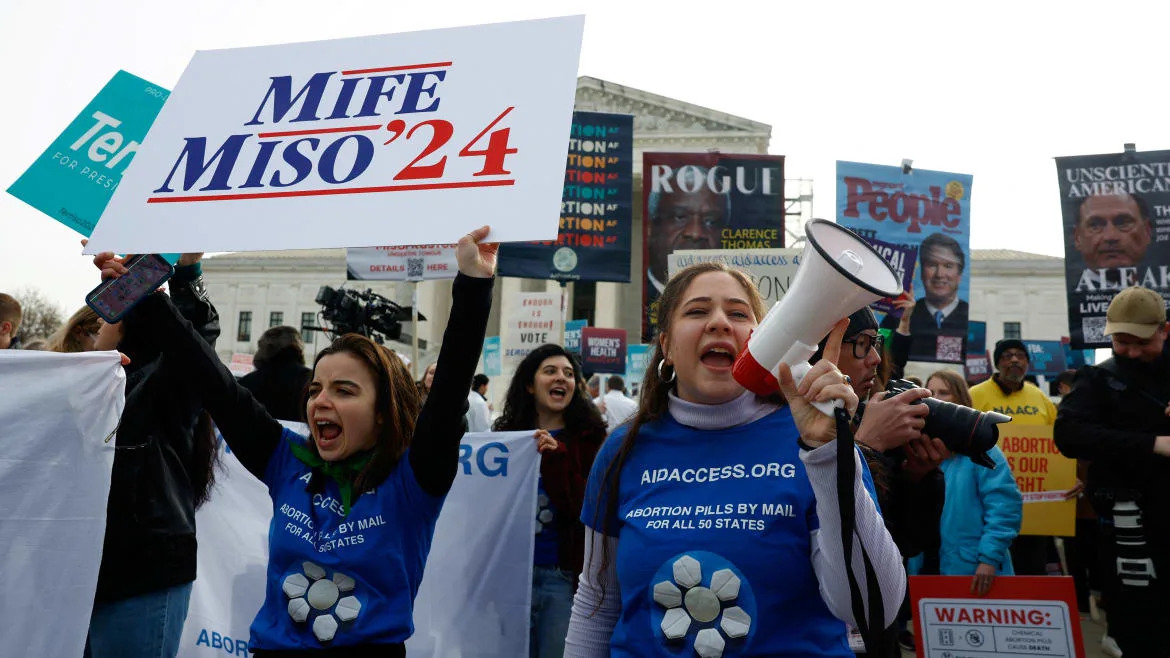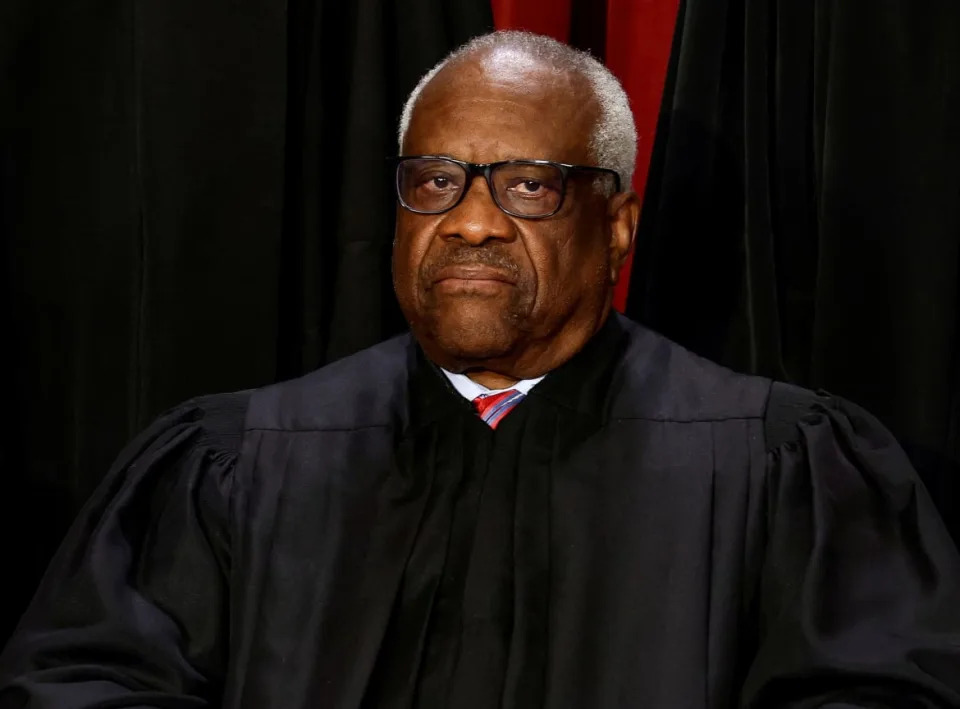Shan Wu
Thu, June 13, 2024

Evelyn Hockstein/Reuter
To borrow a phrase, the import of the Supreme Court’s unanimous decision preserving access to an abortion pill is akin to a “tale told by an idiot, full of sound and fury, signifying nothing.”
Handed down amidst the tempest over Justice Alito’s wife Martha-Ann’s habit of flying politically loaded flags at their houses while he rules on politically loaded cases, and further revelations of Justice Thomas friends-with-hundreds-of-thousands-of-dollars-worth-of-benefits relationship to billionaire conservative Harlan Crow, the case could be seen as an attempt to show the high court can still act with unity even on so-called “liberal causes.”
The Fight Over the Abortion Pill Is Only Just Beginning
One could even speculate that Chief Justice John Roberts managed to persuade his charges to throw a bone to the left in preparation for a yet-to-come decision on Trump’s plea for presidential immunity that will at the very least punt any possibility that Special Counsel Jack Smith can try the Ja.n 6 case before the 2024 election.
But the reality of the ruling in FDA v. Alliance for Hippocratic Medicine is quite different.
On its face, Justice Brett Kavanaugh appeared to revert to a more traditional approach of deciding cases on narrow grounds. Such a style avoids making big decisions whenever possible under the theory that it’s better for jurisprudential health to choose carefully from a buffet of legal choices rather than ravenously consume everything in sight.
Showing off the vigor of a more youthful style of writing, Kavanaugh invoked the ghost of Antonin Scalia in characterizing the doctrine of standing as being “What’s in it for you?” He analyzed whether the plaintiffs —an alliance of doctors and patients—had legal standing to challenge the FDA’s regulation of the drug mifepristone and the practice of it being mailed nationally. Mifepristone, a drug that blocks the hormone progesterone which is critical to pregnancy, is used with another drug misoprostol and accounted for nearly two-thirds of all abortions in the U.S. last year.
Kavanaugh concluded that the plaintiffs’ assertion of “sincere legal, moral, ideological, and policy objections to mifepristone being prescribed and used by others” was not sufficient to meet legal requirements for “standing” to sue. His opinion also pointed that laws already exist that protect doctors from being forced to provide medical treatment that may be “against their conscience.”
The technical nature of the decision, which avoided weighing in on either the legal or moral merits of the debate over abortion, likely made it easier to get unanimity among a court split along liberal and conservative lines. That split reached a zenith last year in the Dobbs decision in which the conservative majority overturned a half-century of protection for women’s right to contraception.
Today, abortion is banned at all stages of pregnancy in 14 states, and after about six weeks of pregnancy in three others, often before women realize they’re pregnant. But the very fact that the decision was decided on technical grounds means that the case is no victory for women’s rights, nor a hint of how the high court will ultimately rule on the abortion drug issue.
Zero doubt exists that the issue is returning to the justices, given that the opinion left room for legal action by three red states—Idaho, Kansas and Missouri—which the extreme-right trial judge had allowed to intervene in the case. Still to come this term is a case to be decided about whether emergency rooms must provide abortions in critical situations.
SCOTUS also skirted the issue of whether the mailing of abortion medication violates the Comstock Act of 1873 which prohibits the mailing of contraceptive aids. As pointed out in Slate, by Dhalia Lithwick and Mark Joseph Stern, “Conservative lawyers and judges are foaming at the mouth to revive this zombie anti-vice law, which puritanical male legislators enacted during a fit of moral panic about women’s equality.”
Thu, June 13, 2024

Evelyn Hockstein/Reuter
To borrow a phrase, the import of the Supreme Court’s unanimous decision preserving access to an abortion pill is akin to a “tale told by an idiot, full of sound and fury, signifying nothing.”
Handed down amidst the tempest over Justice Alito’s wife Martha-Ann’s habit of flying politically loaded flags at their houses while he rules on politically loaded cases, and further revelations of Justice Thomas friends-with-hundreds-of-thousands-of-dollars-worth-of-benefits relationship to billionaire conservative Harlan Crow, the case could be seen as an attempt to show the high court can still act with unity even on so-called “liberal causes.”
The Fight Over the Abortion Pill Is Only Just Beginning
One could even speculate that Chief Justice John Roberts managed to persuade his charges to throw a bone to the left in preparation for a yet-to-come decision on Trump’s plea for presidential immunity that will at the very least punt any possibility that Special Counsel Jack Smith can try the Ja.n 6 case before the 2024 election.
But the reality of the ruling in FDA v. Alliance for Hippocratic Medicine is quite different.
On its face, Justice Brett Kavanaugh appeared to revert to a more traditional approach of deciding cases on narrow grounds. Such a style avoids making big decisions whenever possible under the theory that it’s better for jurisprudential health to choose carefully from a buffet of legal choices rather than ravenously consume everything in sight.
Showing off the vigor of a more youthful style of writing, Kavanaugh invoked the ghost of Antonin Scalia in characterizing the doctrine of standing as being “What’s in it for you?” He analyzed whether the plaintiffs —an alliance of doctors and patients—had legal standing to challenge the FDA’s regulation of the drug mifepristone and the practice of it being mailed nationally. Mifepristone, a drug that blocks the hormone progesterone which is critical to pregnancy, is used with another drug misoprostol and accounted for nearly two-thirds of all abortions in the U.S. last year.
Kavanaugh concluded that the plaintiffs’ assertion of “sincere legal, moral, ideological, and policy objections to mifepristone being prescribed and used by others” was not sufficient to meet legal requirements for “standing” to sue. His opinion also pointed that laws already exist that protect doctors from being forced to provide medical treatment that may be “against their conscience.”
The technical nature of the decision, which avoided weighing in on either the legal or moral merits of the debate over abortion, likely made it easier to get unanimity among a court split along liberal and conservative lines. That split reached a zenith last year in the Dobbs decision in which the conservative majority overturned a half-century of protection for women’s right to contraception.
Today, abortion is banned at all stages of pregnancy in 14 states, and after about six weeks of pregnancy in three others, often before women realize they’re pregnant. But the very fact that the decision was decided on technical grounds means that the case is no victory for women’s rights, nor a hint of how the high court will ultimately rule on the abortion drug issue.
Zero doubt exists that the issue is returning to the justices, given that the opinion left room for legal action by three red states—Idaho, Kansas and Missouri—which the extreme-right trial judge had allowed to intervene in the case. Still to come this term is a case to be decided about whether emergency rooms must provide abortions in critical situations.
SCOTUS also skirted the issue of whether the mailing of abortion medication violates the Comstock Act of 1873 which prohibits the mailing of contraceptive aids. As pointed out in Slate, by Dhalia Lithwick and Mark Joseph Stern, “Conservative lawyers and judges are foaming at the mouth to revive this zombie anti-vice law, which puritanical male legislators enacted during a fit of moral panic about women’s equality.”

U.S. Supreme Court Associate Justice Clarence Thomas poses during a group portrait at the Supreme Court in Washington, U.S., October 7, 2022.
Evelyn Hockstein/File Photo/Reuters
When the high court does finally reach the Comstock law issue, keep an eye out for Justice Alito’s love of ancient misogynistic legal minds like Sir Matthew Hale, the 17th century witch-hunter Alito lovingly cited in Dobbs. The founder of the Comstock law, Anthony Comstock, was a fervent Christian who believed that contraception promoted lust and lewdness, which ought to make Justice Alito drool with fan-boy delight.
The avoidant nature of the unanimous decision may give Chief Justice Roberts some brief respite from the fracturing sounds of a court coming apart at its foundation, and also maybe give the Republicans a little help in making abortion less of an election issue. But the concurring opinion by Justice Thomas makes plain that there is no peace at hand for the conservative Christian warriors on the high court.
In a completely needless concurrence, Thomas pointed out that the very concept of “associational standing” deserves critical legal scrutiny. Thomas makes no effort to hide his real agenda when he writes: “So, just as abortionists lack standing to assert the rights of their clients, doctors who oppose abortion cannot vicariously assert the rights of their patients.”
Note how Thomas does considers patients of “abortionists” to be less than patients. With this assertion, Thomas signals his belief that associations like the NAACP should not be able to sue on behalf of their members. In other words, individuals would need to come forward and sue in their individual capacity. As pointed out by NYU law professor Melissa Murray, this was precisely why the doctrine of associational standing was asserted in 1958 by the NAACP, which argued that making individuals file cases would expose them to threats of violence. She makes plain that Thomas’ attack on the doctrine is a way to restrict civil rights lawsuits.
Ironically, that 1958 NAACP case was argued by a young lawyer and future Supreme Court Justice named Thurgood Marshall. It is Marshall’s seat on SCOTUS that Thomas took over.
No comments:
Post a Comment